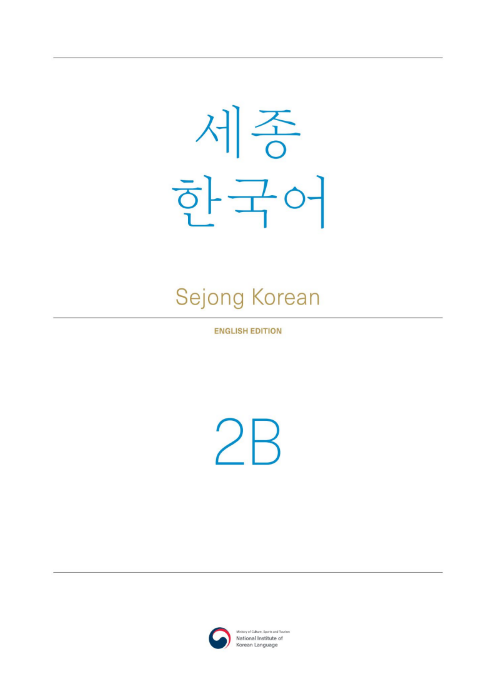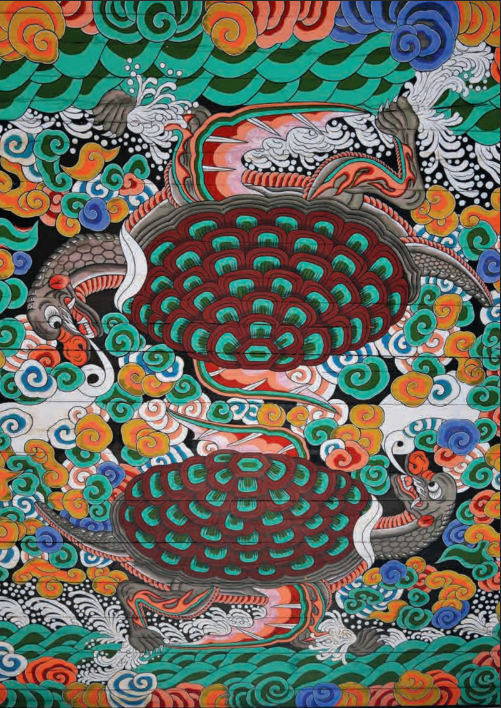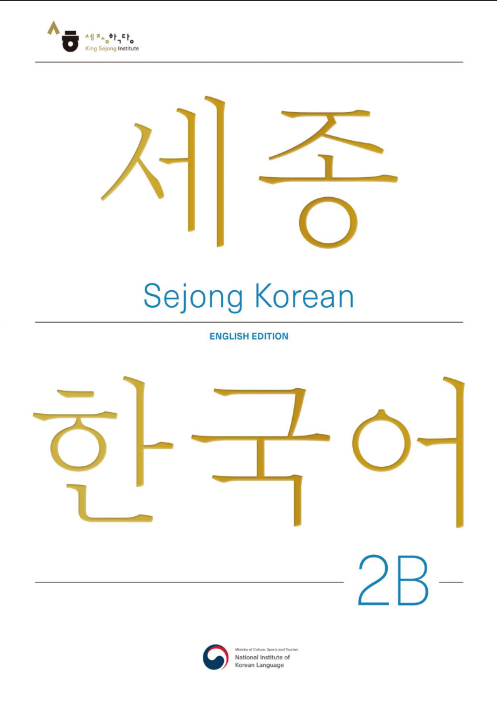


Foreword
Due to the growing scale of the Hallyu (Korean wave) content, the Hallyu culture (Korean culture) is spreading worldwide. As a result, the eagerness to learn Korean is surprisingly increasing. The number of test-takers for the Korean Language Proficiency Test reached over 300,000 in 2021 despite a worldwide slump due to COVID-19. King Sejong Institutes, affiliated with the Ministry of Culture, Sports, and Tourism, have increased in number from 13 in 2007 to 244 in 84 countries in 2022. To support the continuous spread of the Korean Wave, Korean language education should be provided in well-organized ways.
The Ministry of Culture, Sports, and Tourism and the National Institute of Korean Language decided to revise Sejong Korean, first published in 2011, to strengthen the groundwork of Korean language education, which grows along with Hallyu content. For the revising work of the textbook, the primary research started in 2019, and after three years of work, the new Sejong Korean was finally published. Then we announced it with the King Sejong Institute Foundation in 2022.
The newly revised Sejong Korean has the following features. First, it focuses on foreign learners eager to learn Korean at King Sejong Institutes around the world. Second, it has been developed as an instructional material that can be used flexibly according to the learning environment in each King Sejong Institute. Third, the foreigner’s interest in Hallyu content is reflected in the textbook’s content to reduce the learner’s burden of learning Korean. Lastly, it plays a pivotal role as a standard textbook representing the King Sejong Institute and provides a foothold for the next step of Korean language learning.
The King Sejong Institute is Korea’s representative overseas institution for Korean language education. It connects Korea and the world through the Korean language and culture. The National Institute of Korean Language and the Ministry of Culture, Sports, and Tourism will continue cooperating with the King Sejong Institute Foundation by providing continuous efforts and support so that Korean language lovers worldwide can achieve their dreams.
Lastly, I would like to sincerely thank the research and writing staff as well as publishers for their best efforts in developing the textbook. With the new start of Sejong Korean, I would appreciate your warm interest so that the Ministry of Culture, Sports, and Tourism, the National Institute of Korean Language, and the King Sejong Institute Foundation can expand their reach throughout the world.
August 2022
Chang Sewon
Director, National Institute of Korean Language
Preface
The King Sejong Institute is an organization that connects Korea and the world by spreading the Korean language and culture worldwide. This book aims to enable learners to improve their communication skills in Korean by motivating their interest in learning the Korean language based on cross-cultural communication. To this end, the current situations in Korea have been reflected in the content of this book, and a new format and design are applied to introduce the latest teaching methods. We tried to present a new direction for overseas Korean language education. The features of this book are as follows:
First, there are two kinds of books, such as a ‘student book’ and an ‘extension activity book,’ so that instructors can use both of them flexibly in Type 7, or Type 다, which is part of the standard curriculum of the King Sejong Institute. The ‘student book’ contains the core content required for each level, and the ‘extension activity book’ provides a variety of communication activities that require in-depth expansion of language knowledge. This flexibility allows learners to select the right book for their learning environment.
Second, the units are composed in different formats according to levels for effective teaching and learning. Also, this book applies the teaching as well as learning content and procedures relevant to the language development stage. In particular, various illustrations and visual materials motivate a learner’s interest in learning Korean.
Third, we present vivid Korean cultural content throughout the book so learners can understand Korean culture from a cross-cultural point of view. As a result, learners can develop the right attitude towards their and Korean cultures.
Fourth, we provide workbooks, teacher’s guides, vocabulary and grammar books, and class PPTs along with textbooks so instructors and learners can use them for their needs.
I would like to thank the National Institute of Korean Language for joining the entire production of this book from planning to the end. I would also like to thank the King Sejong Institute Foundation for its cooperation and support with local institutes worldwide. Also, I appreciate Kong & Park Publishing Company for designing this book for learners to learn Korean in a fun way. Lastly, I would like to thank the researchers who contributed all their efforts to this book with their love for Korean language education for almost three years.
August 2022
First Author Lee Jung Hee
Professor, Institute of International Education Kyung Hee University
Contents
Foreword…………………………………………………… 3
Preface…………………………………………………….. 4
Scope and Sequence…………………………………………… 6
How to Use This Book………………………………………… 6
Characters…………………………………………………. 11
Time Spent With Friends
01 Do you want to have a club gathering this Friday?…………………….. 13
02 It takes about ten minutes from the King Sejong Institute……………….. 21
Something Special to Me
03 My grandmother made this necklace herself…………………………… 29
04 I met my middle school friend on my way to the King Sejong Institute………. 37
Essential Etiquette
05 Don’t use your cell phone during performances………………………. 45
06 Can I use my laptop here?………………………………………… 53
Various Personalities and Characteristics
07 I heard about her from Mari………………………………………. 61
08 I used to have long hair when I was younger, but now I find short hair more comfortable…. 69
My Wish List
09 I want to meet someone like that, too!…………………………….. 77
10 Mountain bikes are a little dangerous………………………………. 85
Good Changes
11 At first, I was frustrated because there were so many things I didn’t know……… 93
12 I want to run a café like you……………………………………… 101
Appendix
Listening Scripts……………………………………………. 110
Answer Key………………………………………………… 114
Vocabulary index…………………………………………… 126
Credits…………………………………………………… 130
Scope and Sequence
| Unit | Topic | Title | Function |
| 1 | Time Spent With Friends | Do you want to have a club gathering this Friday? | Suggesting and recommending |
| 2 | It takes about ten minutes from the King Sejong Institute | Giving directions | |
| 3 | Something Special to Me | My grandmother made this necklace herself | Introducing |
| 4 | I met my middle school friend on my way to the King Sejong Institute | Describing | |
| 5 | Essential Etiquette | Don’t use your cell phone during performances | Expressing prohibition |
| 6 | Can I use my laptop here? | Expressing permission | |
| 7 | Various Personalities and Characteristics | I heard about her from Mari | Describing |
| 8 | I used to have long hair when I was younger, but now I find short hair more comfortable | Comparing | |
| 9 | My Wish List | I want to meet someone like that, too! | Explaining |
| 10 | Mountain bikes are a little dangerous | Explaining | |
| 11 | Good Changes | At first, I was frustrated because there were so many things I didn’t know | Comparing |
| 12 | I want to run a café like you | Asking and answering questions |
Vocabulary and Expressions
| Vocabulary and Expressions | Grammar | Pronunciation | Activity |
| Preparing for a gathering | -(으)ㄹ래요? | Nasalization | Taking about planning gatherings, Writing an invitation to a party |
| How to move | -(으)ㄹ거 (future tense of verbs) | Talking about how to move, Writing an e-mail inquiring about an event | |
| Gifts | -(으)시-, 예:게, 예:도 | Tensification | Introducing precious gifts, Writing about precious gifts |
| Feelings | -기, -아/어 주다 | Taking about feelings, Writing about special experiences | |
| Audience etiquette for performances | -네요, -지 말다 | Intonation (Exclamatory sentences) | Talking about audience etiquette for performances, Writing about rules for a concert hall |
| Rules for public places | -이/어도 되다, -(으)면 안 되다 | Talking about rules for public places, Writing about rules for public places | |
| Personality | -에서, -한테서, 께 | -(으)니까 (Discovery) | Talking about a friend’s personality, Writing an introduction about a close friend |
| Appearance | -는데(는) | Pause | Comparing your childhood and your present self, Writing about your childhood dreams and your current job |
| A person’s characteristics | -기 때문에 | -는데요 | Describing a person you would like to meet, Writing about a person you would like to get along with |
| Special experience | -(으)ㄴ/는 편이다 | -게 | Talking about your bucket list, Writing about what you really want to do this year |
| Change | -(아/어)서, 에서는 | Intonation (Informal interrogative sentence) | Talking about changes in yourself, Writing a paragraph expressing your feelings to your friends |
| Wishes | -(으)려면, -게 되다 | Talking about wishes, Writing about what you would like to do |


